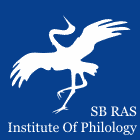 |
|
||||||||||||
|
Institute of Philology of
the Siberian Branch of Russian Academy of Sciences |
|
||||||||||||
|
|||||||||||||
DOI: 10.25205/2307-1737 Roskomnadzor certificate number Эл № ФС 77-84784 | |
| Kritika i Semiotika (Critique and Semiotics) | |
|
Article
Authors: Anna A. Bogoderova Novosibirsk State Technical University, Novosibirsk, Russian Federation; Institute of Philology of the Siberian Branch of the Russian Academy of Sciences, Novosibirsk, Russian Federation
Abstract: The article is devoted to the analysis of the restaurant locus in the works of Russian emigrants of the eastern branch about Shanghai. Restaurants, bars, cabarets and taverns were a characteristic feature of Shanghai's urban environment, which emigrants had to mentally and artistically master. Shanghai with its international culture and tense, energetic life of a big capitalist city was noticeably different not only from Russia, but also from another eastern center of the Russian abroad – Harbin. The literary works of the following authors were considered: E. Magaram, S. Alymov, V. Rambaev, A. Petrov, G. Kochurov, N. N. Ivanitsky, A. Nentsinsky, J. Lovic, P. Severny, N. I. Ilyina. The restaurants depicted in the texts examined are jazz-era entertainment institutions with a specific atmosphere that barely supposes a meal but includes alcohol, aggressive music, and indecent dancing. This is a place for debauchery, intoxication and violent fights. The pleasure of the rude crowd is achieved at the expense of humiliating dancing girls, musicians, and artists. The negative impression is intensified by the use of contrast. In some works, the pernicious restaurant locus is contrasted with a quiet family home. In others, the characters, in order to save themselves, must leave not only the restaurant, but also Shanghai itself, and seek their place outside in the big world. The restaurant binge reflects Shanghai's inherent thirst for strong impressions and maximum vigor, and both loci are rejected by the authors. Keywords: restaurant locus, cabaret, bar, pub, Shanghai, Russian emigrants Bibliography: Andersen L. N. Odna na mostu: Stikhotvoreniya. Vospominaniya. Pis'ma [Alone on the bridge. Poems. Memories. Letters]. Moscow, 2006, 377 p. (in Russ.) Arkhangelskaya R. I. Russkoe kabare kak fenomen kul'tury: istoricheskii ocherk [Russian cabaret as a cultural phenomenon: historical sketch]. Culture and art, 2018, no. 10, pp. 16–22. (in Russ.) DOI 10.7256/2454-0625.2018. 10.27682 Brandt G. A., Kovaleva A. Yu. Bogema Serebryanogo veka: kody i smysly [Silver Age Bohemians: Codes and Meanings]. Yaroslavl Pedagogical Bulletin, 2017, no. 2, pp. 323–328. (in Russ.) Kaliberova T. N. Larissa Andersen: mif i sud'ba [Larissa Andersen: myth and destiny]. In: Andersen L. N. Odna na mostu: Stikhotvoreniya. Vospominaniya. Pis'ma [Alone on the bridge. Poems. Memories. Letters]. Moscow, Russ-kii put'; Biblioteka-fond “Russkoe zarubezh'e”, 2006, pp. 8–39. (in Russ.) Kikhney L. G., Gavrikov V. A. “Kabatskii lokus” v russkoi poezii XX veka: stat'ya pervaya (simvolizm i akmeizm) [“The tavern locus” in the Russian poet-ry of the 20th century. Article 1. Symbolism and Acmeism]. The New Philologi-cal Bulletin, 2019, no. 4 (51), pp. 228–246. (in Russ.) Kikhney L. G., Gavrikov V. A. “Kabatskii lokus” v russkoi poezii XX veka: stat'ya vtoraya [“The tavern locus” in the Russian poetry of the 20th century. Article 2]. The New Philological Bulletin, 2020, no. 2 (53), pp. 204–220. (in Russ.) Kikhney L. G., Temirshina O. R. “Vse my brazhniki zdes'...” Restorannyi tekst v poezii Serebryanogo veka [“Vse my brazhniki zdes...” The restaurant text in the Silver Age poetry]. Tomsk State University Journal of Philology, 2018, no. 55, pp. 212–227. (in Russ.) DOI 10.17223/19986645/55/14 Magomedova D. M. Razvlechenie ili infernal'nyi lokus? Demonizatsiya razvlechenii v literature simvolizma: teatr, bal, restoran, kazino [Entertainment or infernal locus? The demonization of entertainment in Symbolist literature: thea-ter, ball, restaurant, casino]. In: Russkaya razvlekatel'naya kul'tura Serebryanogo veka, 1908–1918 [Russian entertainment culture of the Silver Age, 1908–1918]. Moscow, HSE Press, 2017, pp. 31–44. (in Russ.) Pavlov S. G., Fomicheva E. D. Infernalnye lokusy v romane M. Bulgakova “Master i Margarita” [Infernal loci in M. Bulgakov’s novel “The Master and Margarita”]. Vestnik Nizhegorodskogo universiteta im. N. I. Lobachevskogo [Vestnik of Lobachevsky University of Nizhni Novgorod], 2021, no. 5, pp. 209–217. (in Russ.) Poltoratsky I. S. Shankhayskii tekst v romane Sergeya Alymova “Nankin-rod” [Shanghai text in Sergei Alymov’s novel “Nanjing-Road”]. Syuzhetologiya i syuzhetografiya [Plot Description and Analysis], 2022, no. 2, pp. 175–185. (in Russ.) DOI 10.25205/2410-7883-2022-2-175-185 Ponomarev E. R. Stolichnyi restoran kak fenomen russkoi zhizni fin de siè-cle (ot Turgeneva, Dostoevskogo i Tolstogo k Kuprinu i Buninu) [The Capital Restaurant as a Phenomenon of Fin-de-Siècle Russian Life. From Turgenev, Dostoevsky, and Tolstoy to Kuprin and Bunin]. Novoye literaturnoe obozrenie [New Literary Observer], 2018, no. 1 (149), pp. 132–144. (in Russ.) Staroselskaya N. D. Povsednevnaya zhizn' “russkogo” Kitaya [Daily life of “Russian” China]. Moscow, 2006, 376 p. (in Russ.) Tashlykov S. A. Khronotop traktira v khudozhestvennom mire A. I. Kuprina [The chronotope of the tavern in A. I. Kuprin’s short stories]. Sibirskii Filologicheskii Zhurnal [Siberian Journal of Philology], 2010, no. 1, pp. 39–47. (in Russ.) Williams M. The Modern Cafe in Literature. Studies in the English Lan-guage & Literature, 2018, no. 83, pp. 17–50. |
 |
Institute of Philology Nikolaeva st., 8, Novosibirsk, 630090, Russian Federation +7-383-330-15-18, ifl@philology.nsc.ru |
© Institute of Philology |


